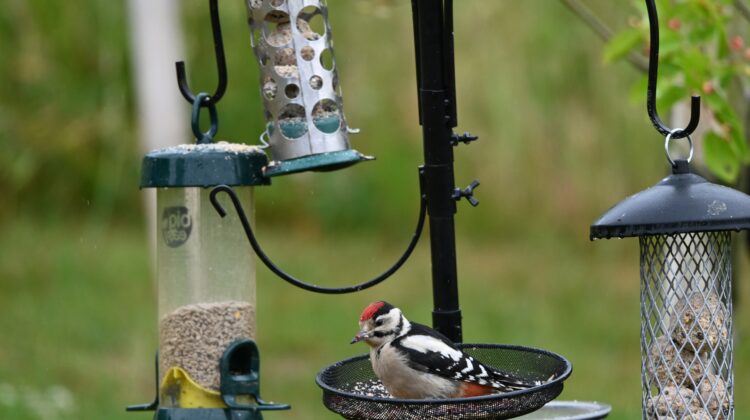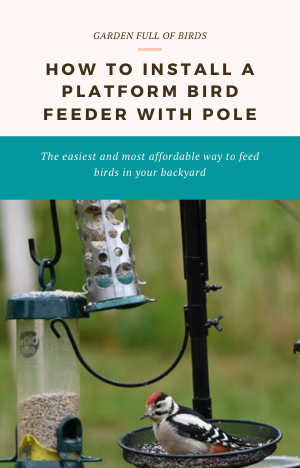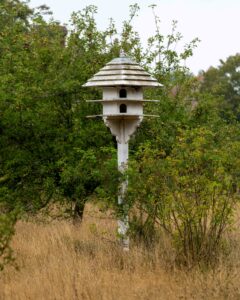
If you are just getting started feeding birds in your garden, you can’t go wrong with a platform bird feeder with a pole. They are easy to install and work for all types of birds: those who eat from the ground and perching birds.
As the name implies, a platform bird feeder with pole is mounted over a pole and can be placed anywhere in the garden that has ground deep enough to guarantee stability. They can also be mounted on a pedestal if you want, but usually a pole is easier and takes less ground space. A platform bird feeder is a great choice if you want to attract a wide variety of different birds, and most people will use a wide-appealing mix of grains and seeds on theirs. Unlike hopper feeders, platform feeders won’t protect the seed from the elements so they are better as summer bird feeders.

What Is a Platform Bird Feeder With Pole?
A platform bird feeder is a basically a wide tray or platform, usually hanging from a tree branch or in our case mounted on top of a suitable feeder pole. They attract the widest variety of seed-eating birds, with pigeons, starlings and sparrows being frequent guests. The best platform bird feeders will have a screened bottom or drainage holes as otherwise wet seeds will sprout or develop fungal and bacterial growth. Some models come with a roof that offers some protection from the elements but even at its best the seeds will be exposed to rain or wind.

Since platform feeders allow for full view of their contents, they make an awesome feeder for bird watching in your garden. If you install it anywhere within good line of sight you can enjoy lots of different birds through your window. Smaller ones often hang from a pole but larger ones should be installed on top of the pole as a platform to avoid them falling off.
Word of warning, unless you protect your bird feeder from squirrels, expect the little critters to come visit and disturb your birds. If you want to enjoy watching squirrels eat, it’s better to install a dedicated squirrel feeder for them and squirrel-proof your bird feeder.
Where To Install A Platform Bird Feeder With Pole
You can install a platform bird feeder with pole at different heights. Placed near the ground, they will attract ground-feeding species such as doves, jays, blackbirds, sparrows and juncos. But they will also attract rodents and mammals: expect to see squirrels, deer, raccoons and other non-flying visitors. Most importantly, a ground level feeder can become a cat and fox feeding station which is less than ideal.
Higher placed tray feeders will attract finches, chickadees and cardinals as well, depending on your area. They are also less likely to attract deer but squirrels will always give it a go. Big birds may become bullish against smaller ones and take over the feeder, so it’s important to keep an eye on the bird feeder visitors.
If you are installing the feeder to watch birds, it makes sense to install it at a height that will make the most of it. Figure out where you’ll be watching from and ensure the platform is at eye level when you are in that location. But keep in mind the practicalities. Tray feeders must be refilled and cleaned often, and should never hold more than a day or two worth of feed. A pole that is 10 feet tall will make this difficult, however lovely the view is from your living room window.
If you want to maximise the amount of birds that visit the feeding station, try to work with the environment. It is very difficult to attract shy birds to a feeder that is standing in full view, without any bushes nearby that could be used to hide from predators. Too exposed! While sparrows and blackbirds will eat from anywhere, other birds such as cardinals will require a slightly more secure and protected environment. The more natural and organic the placement, the more likely you add to get more exotic visitors to your tray feeder. Use bushes and plants to your advantage to provide shy birds with cover and to make the feeder look part of your garden and you won’t regret the extra effort .
How To Install A Tray Feeder Securely On a Pole
As a rule of thumb, the pole will need to be dug into the ground for about 25/30% of its length to be secure. But this is not a perfect mathematical formula! You will need to take into consideration the size of the feeder, the weight of the feeder and the food combined and whether there is a risk of heavy winds or lots of snow accumulating on it. Check the type of soil as well: If you are digging the pole straight into the ground without building a foundation you’ll need to dig much deeper on a soft soil. If your soil is heavy clay, for example, it will hold the pole much better.
In case of doubt, or if you plan to install a large platform feeder on a pole, it may be a good idea to mount it on concrete. If your area suffers from heavy winds and snow conditions, and you want the feeder to last more than a season, a concrete mounted pole is nearly always the best option. Keep in mind that if the wind topples the tray it will not only be a mess, but scare the birds and a heavy feeder could cause significant damage to people or property.
Make sure that the tray is well attached to the pole. The bottom should be accessible so it can be removed and cleaned regularly with a hose. Dirt and rotting seed can be a source of disease for the birds and will attract unwanted attention from the wildlife.
Maintaining A Platform Feeder
Tray feeders are very appealing to a large variety of birds, and due to their shape you are not blocked from using any kind of food. From small seeds to fruit, all can go on the platform. This doesn’t mean all should go, or you are likely to attract rats.
The best way to keep a platform feeder in good condition is ensuring food isn’t there for long. A one or two days food supply is more than enough and the birds will eat it before it has a chance to mould or rot. Keep an eye on how many birds visit the feeder, and throw away uneaten food (and add less next time). It is better to just add more food as needed, instead of leaving it to spoil.
When you change the food, get into the habit of shaking the bottom of the feeder and cleaning it with a quick hose down if there has been rain or humidity that would make the seeds and food stick to it. Most birds are quite messy eaters, and the area around the feeder may end up collecting a lot of seeds and bird droppings. Ground-feeding birds will eat some of that food, but it’s best to give a quick dusting under the feeder regularly to avoid accumulating waste there.
Given the flexibility in terms of food that you can use on a platform feeder, the options are limitless. Choose the favourite food of the birds that you want to attract. For example, you can use the best bird food for cardinals, or black sunflower seeds to appeal to chickadees, finches, titmice, grosbeaks, nuthatches and sparrows, cardinals, jays, mourning doves, and woodpeckers. Nuts will appeal to squirrels so squirrel proof your feeder if you want to use them.
If you choose to add fresh fruit to your bird feeder you’ll need to become militant about cleaning uneaten food before it has a chance to spoil and attract flies and other insects.
Leave a Reply